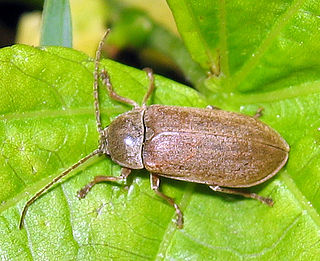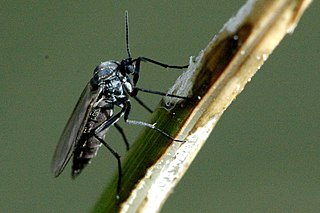
Pipunculidae is a family of flies (Diptera) commonly termed big-headed flies, a reference to the large (holoptic) eyes, which cover nearly the entire head. The family is found worldwide and more than 1300 species have been described.

Dictyopharidae is a family of bugs in the suborder Auchenorrhyncha belonging to the infraorder Fulgoromorpha. The family comprises nearly 760 species in more than 150 genera which are grouped into two subfamilies, Dictyopharinae and Orgeriinae.
Cupes is a genus of beetles in the family Cupedidae. The Cupedidae are typical “reticulate” or “net-winged” beetles with incompletely sclerotized elytra that produce the characteristic reticulate appearance.
Palaeomedeterus is an extinct genus of flies in the family Dolichopodidae, known from Baltic amber from the Eocene. The genus was first proposed by Fernand Meunier in 1895 with no included species or description, though illustrations were provided for six different unnamed species.
Wheelerenomyia is an extinct genus of flies in the family Dolichopodidae, known from the Eocene of the Baltic region. The genus was first described in 1907 by Fernand Meunier, who named it after William Morton Wheeler. It is close to the Mesorhagini.

Euphaeidae, sometimes incorrectly named Epallagidae and commonly called gossamerwings, is a family of damselflies in the odonate superfamily Calopterygoidea. The family is small, consisting of around 78 species living species in nine genera occurring in the Palearctic, Australasia, and Asia. The family contains two subfamilies, Euphaeinae, encompassing all the living species and a single fossil genus, and the extinct Eodichromatinae, encompassing fossil genera from the Eocene to late Oligocene. Euphaeid species are large and mostly metallic-coloured, looking similar to species of damselflies in the family Calopterygidae.
Panorpodes is a genus of scorpionflies in the family Panorpodidae, containing the following species:
Microperittia is an extinct genus of moths in the family Elachistidae. It was described by Kozlov in 1987. It contains the species M. proboscifera, which was described from Baltic amber, more specifically Priabonian terrestrial amber in the Russian Federation.

Paraneuretus is an extinct genus of formicid in the ant subfamily Aneuretinae known from fossils found in Asia and Europe. The genus contains three middle to late Eocene age species, Paraneuretus dubovikoffi, Paraneuretus longicornis, and Paraneuretus tornquisti.

Plecia is a genus of March flies (Bibionidae).
Gnoristinae is a subfamily of fungus gnats in the family Mycetophilidae. There are about 6 genera and at least 4 described species in Gnoristinae.

Dascillidae is a family of soft-bodied plant beetles in the order Coleoptera. There are at least 15 genera and about 80 described species in Dascillidae.
Systenites is an extinct genus of flies in the family Dolichopodidae, known from Baltic amber.

Winnertziinae is a subfamily of gall midges and wood midges in the family Cecidomyiidae.
Heteropeza is a genus of gall midges and wood midges in the family Cecidomyiidae. There are about six described species in Heteropeza.

Winnertzia is a genus of gall midges and wood midges in the family Cecidomyiidae. There are more than 90 described species in Winnertzia.
Prohercostomus is an extinct genus of flies in the family Dolichopodidae, known from Baltic amber from the Eocene. It was originally created as a subgenus of Hercostomus, but was later raised to genus rank.

Rymosia is a genus of flies belonging to the family Mycetophilidae.

Tetragoneura is a genus of flies belonging to the family Mycetophilidae.
Syntemna is a genus of flies belonging to the family Mycetophilidae.









